Experimental Study on the Mechanical Behavior of Orthodontic Arches Exposed to the Environment in the Oral Cavity
Abstract
1. Introduction
2. Materials and Methods
2.1. Purpose of the Study
2.2. Working Method
3. Results
4. Discussion
5. Conclusions
Author Contributions
Funding
Institutional Review Board Statement
Informed Consent Statement
Conflicts of Interest
References
- Zetu, I.; Păcurar, M. Ortodonție-Tehnica Arcului Drept; Editura Lyra: Târgu Mureș, Romania, 2000. [Google Scholar]
- Downing, A.; McCabe, J.F.; Gordon, P.H. The Effect of Artificial Saliva on the Frictional Forces between Orthodontic Brackets and Archwires. Br. J. Orthod. 1995, 22, 41–46. [Google Scholar] [CrossRef] [PubMed]
- pdfcoffee.com. Rezistenta Materialelor_DUDESCU.Pdf. Available online: https://pdfcoffee.com/rezistenta-materialelordudescupdf-pdf-free.html (accessed on 18 November 2021).
- Acharya, A.; Jayade, V.P. Metallurgical Properties of Stainless Steel Orthodontic Archwires: A Comparative Study. Trends. Biomat. 2005, 18, 125–136. [Google Scholar]
- Chahine, N.; Mouhoubi, K.; Bodnar, J.-L.; Toumi, Y.; Millet, P.; Benmarouwan, A.; Harakeh, S. The evolution of the mechanical properties of orthodontic arches by stimulated infrared thermography. Opt. Methods Insp. Charact. Imaging Biomater. IV 2019, 11060, 110600K. [Google Scholar] [CrossRef]
- Demian, T.; Tudor, D.; Curița, I.; Nițu, C. Bazele Proiectarii Aparatelor de Mecanică Fină; Editura Tehnica: Bucureşti, Romania, 1984; Volume 1. [Google Scholar]
- Albea, C. Accuracy and Consistency of Preformed Orthodontic Arch Wires and the Effect of Energy Drinks. Master’s Thesis, Nova Southeastern University, Fort Lauderdale, FL, USA, 2016. Available online: https://nsuworks.nova.edu/hpd_cdm_stuetd/107 (accessed on 18 November 2021).
- Chantarawaratit, P.-O.; Yanisarapan, T. Exposure to the oral environment enhances the corrosion of metal orthodontic appliances caused by fluoride-containing products: Cytotoxicity, metal ion release, and surface roughness. Am. J. Orthod. Dentofac. Orthop. 2021, 160, 101–112. [Google Scholar] [CrossRef] [PubMed]
- Schiff, N.; Grosgogeat, B.; Lissac, M.; Dalard, F. Influence of fluoridated mouthwashes on corrosion resistance of orthodontics wires. Biomaterials 2004, 25, 4535–4542. [Google Scholar] [CrossRef] [PubMed]
- Małkiewicz, K.; Sztogryn, M.; Mikulewicz, M.; Wielgus, A.; Kaminski, J.; Wierzchoń, T. Comparative assessment of the corrosion process of orthodontic archwires made of stainless steel, titanium–molybdenum and nickel–titanium alloys. Arch. Civ. Mech. Eng. 2018, 18, 941–947. [Google Scholar] [CrossRef]
- Pop, S.I.; Dudescu, M.; Merie, V.V.; Pacurar, M.; Bratu, C.D. Evaluation of the mechanical properties and surface topography of as-received, immersed and as-retrieved orthodontic archwires. Clujul Med. 2017, 90, 313–326. [Google Scholar] [CrossRef] [PubMed]
- Available online: https://shop.dentaurum.de/index.php?id=p&psn=6956&pgsn=3145&ch=38a382 (accessed on 29 August 2021).
- Pandis, N. Linear regression. Am. J. Orthod. Dentofac. Orthop. 2016, 149, 431–434. [Google Scholar] [CrossRef] [PubMed]
- Pandis, N. Statistical methods for the assessment of orthodontic materials. Am. J. Orthod. Dentofac. Orthop. 2013, 143, S176–S179. [Google Scholar] [CrossRef] [PubMed]
- Kusy, R.; Dilley, G. Materials Science Elastic Modulus of a Triple-stranded Stainless Steel Arch Wire via Three- and Four-point Bending. J. Dent. Res. 1984, 63, 1232–1240. [Google Scholar] [CrossRef] [PubMed]
- Kusy, R.P. A review of contemporary archwires: Their properties and characteristics. Angle Orthod. 1997, 67. [Google Scholar] [CrossRef]
- Abalos, C.; Paul, A.; Mendoza, A.; Solano, E.; Palazon, C.; Gil, F.J. Influence of Soft Drinks with Low pH on Different Ni-Ti Orthodontic Archwire Surface Patterns. J. Mater. Eng. Perform. 2012, 22, 759–766. [Google Scholar] [CrossRef][Green Version]
- Parvizi, F.; Rock, W.P. The load/deflection characteristics of thermally activated orthodontic archwires. Eur. J. Orthod. 2003, 25, 417–421. [Google Scholar] [CrossRef] [PubMed]
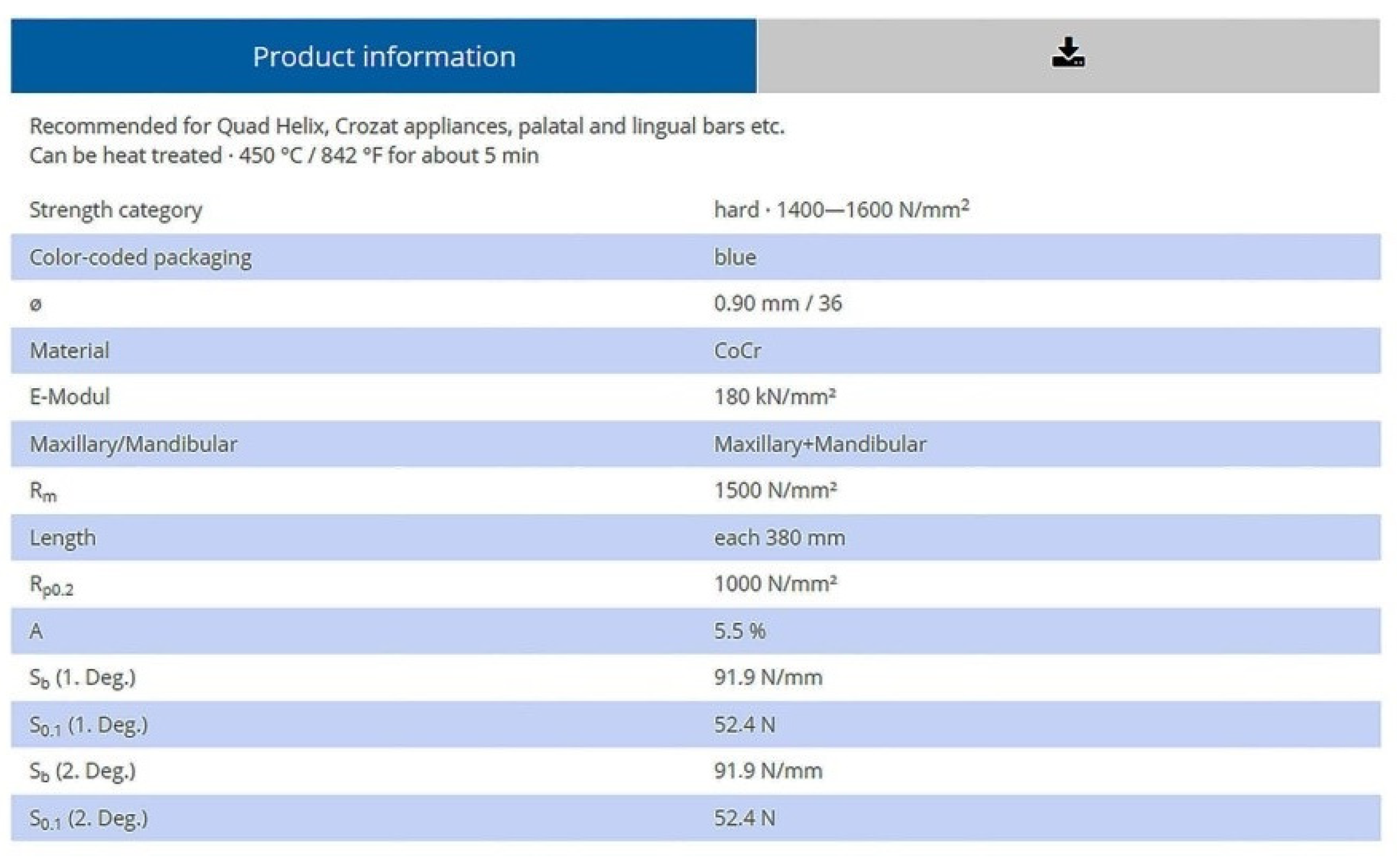
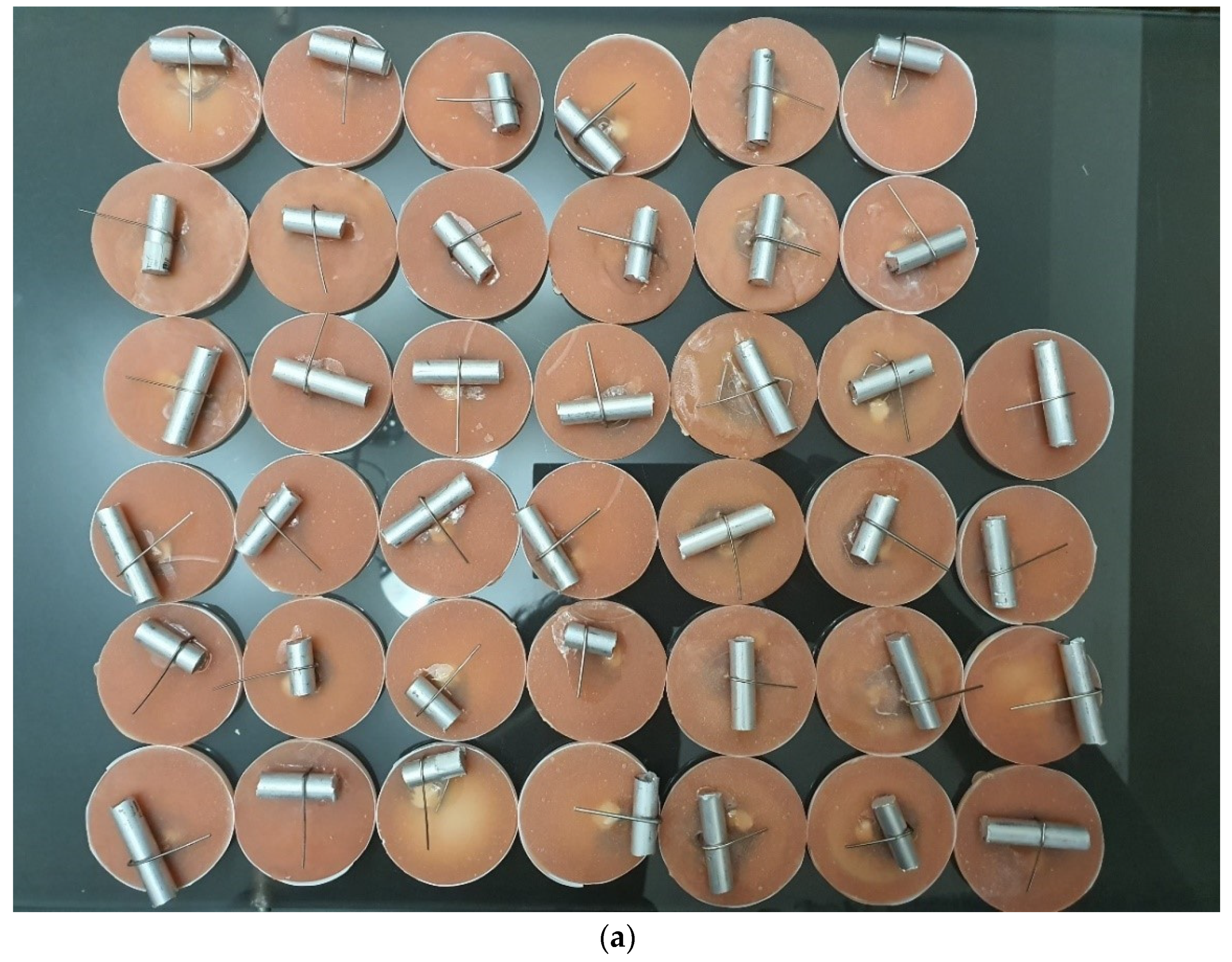
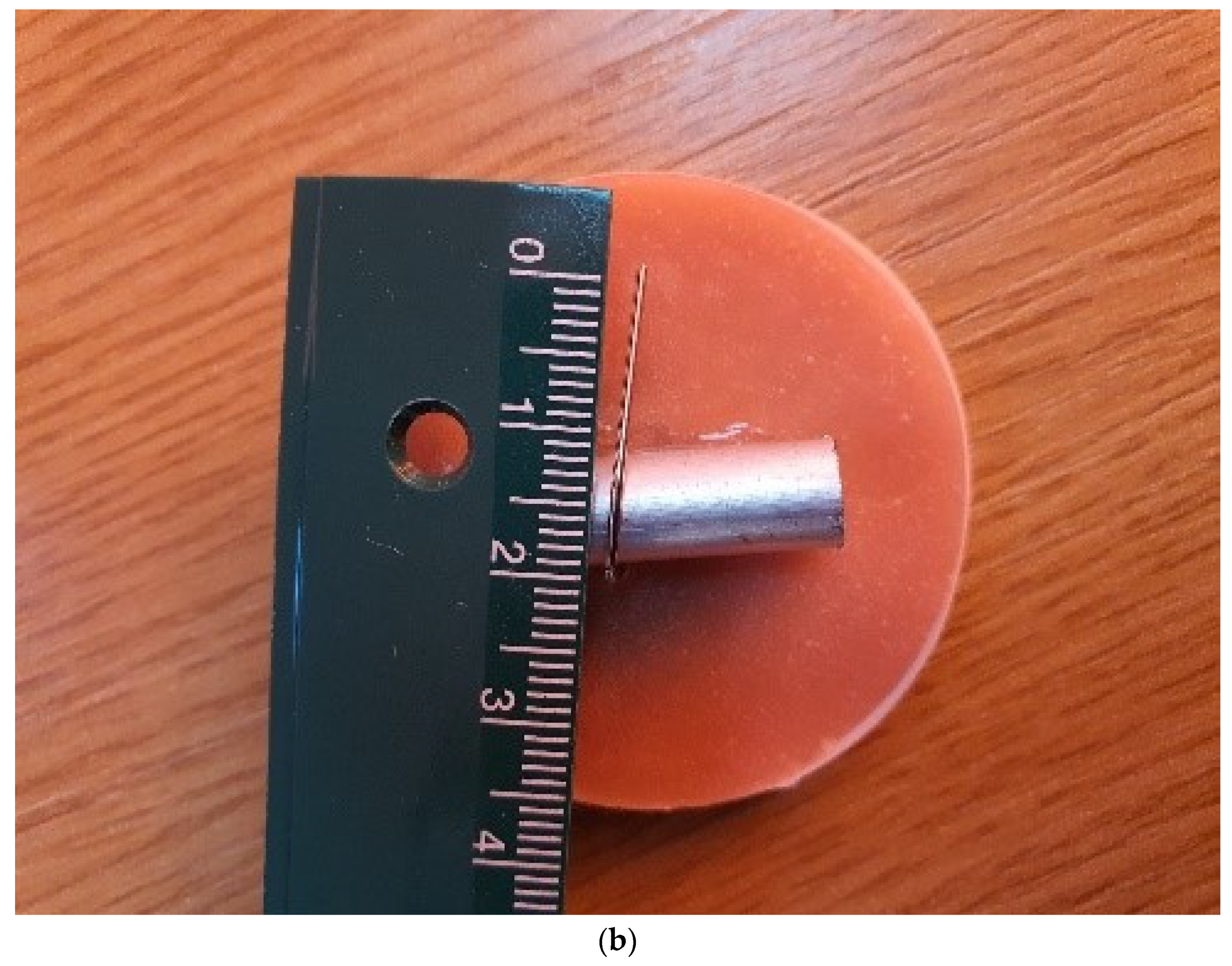
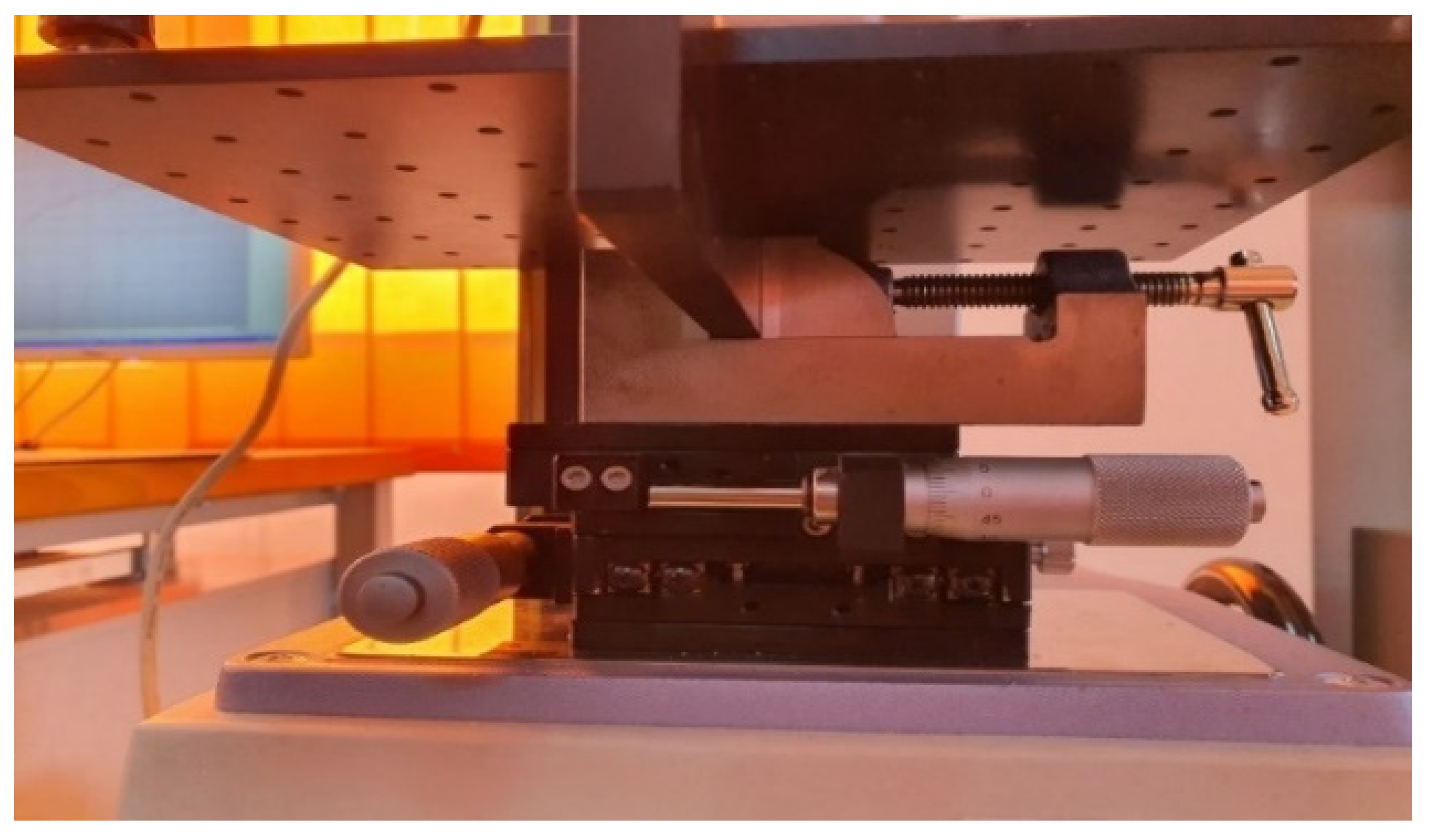
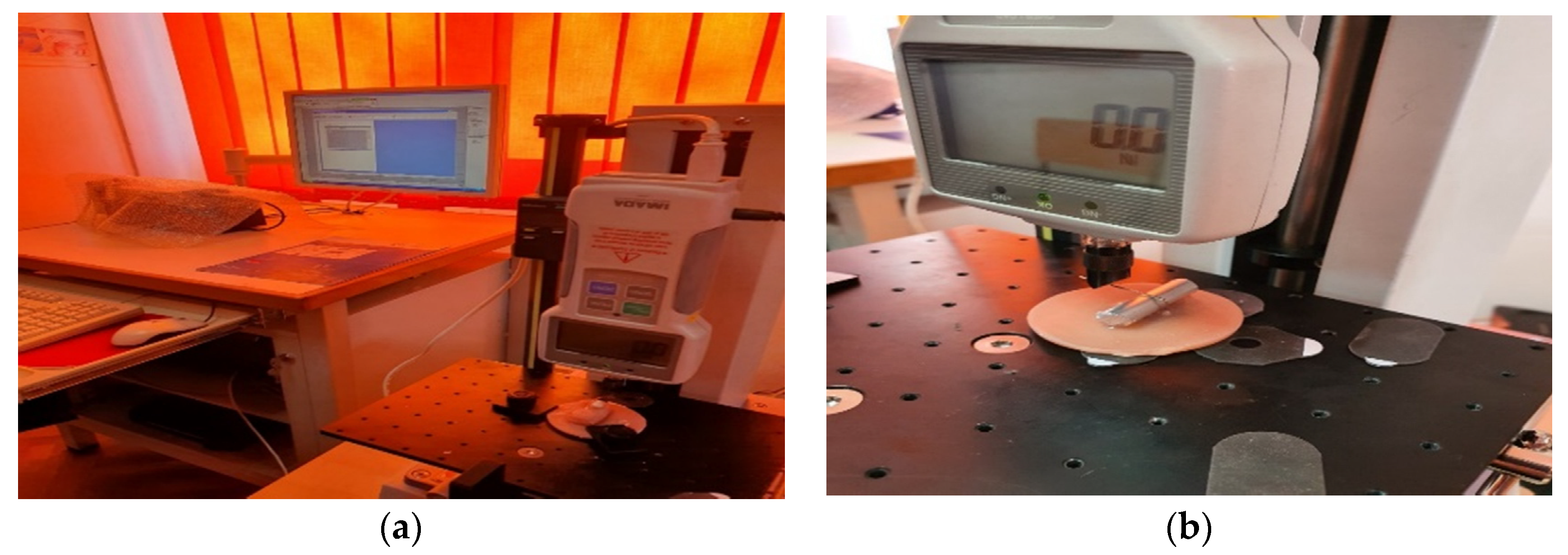

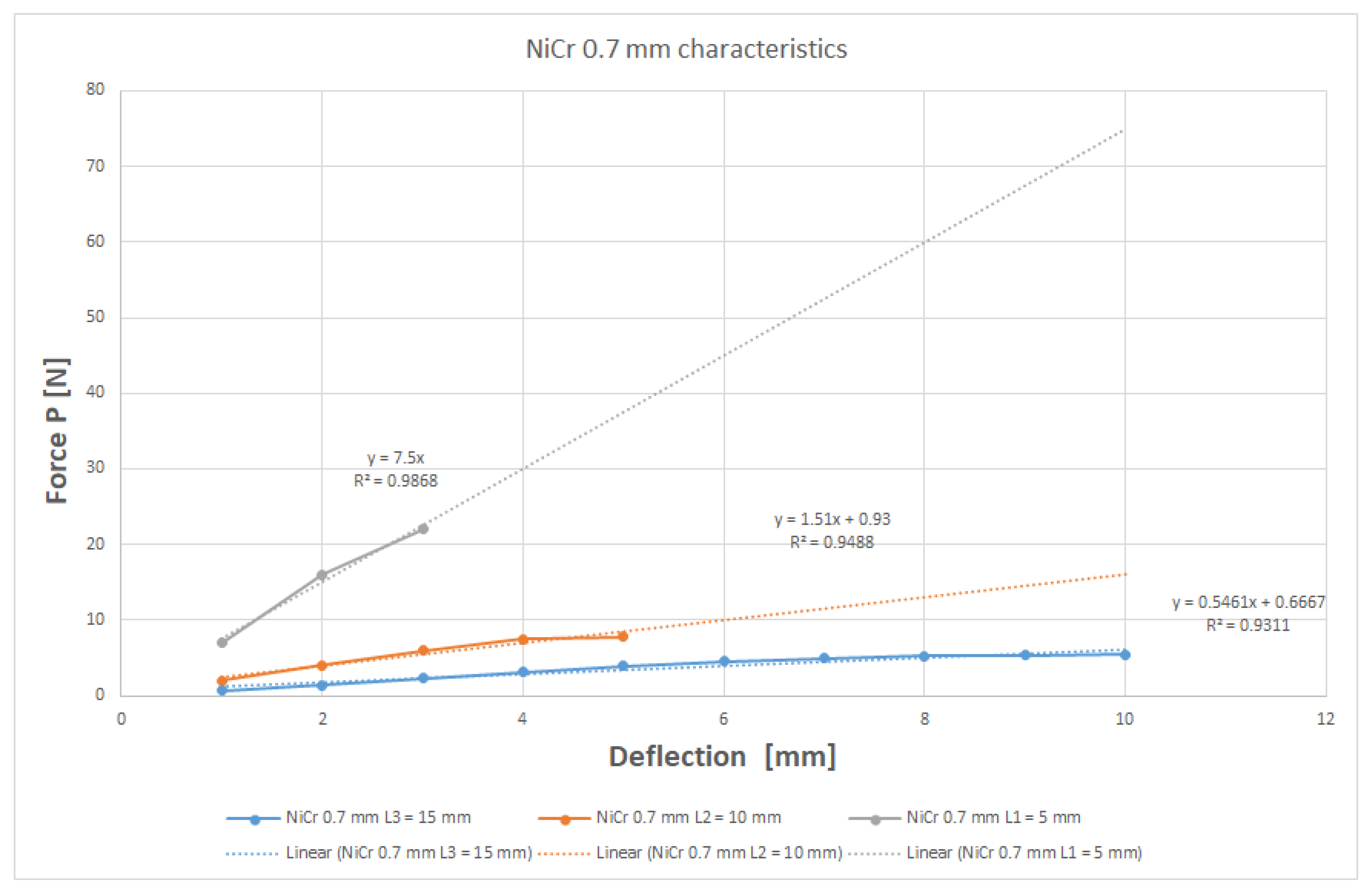

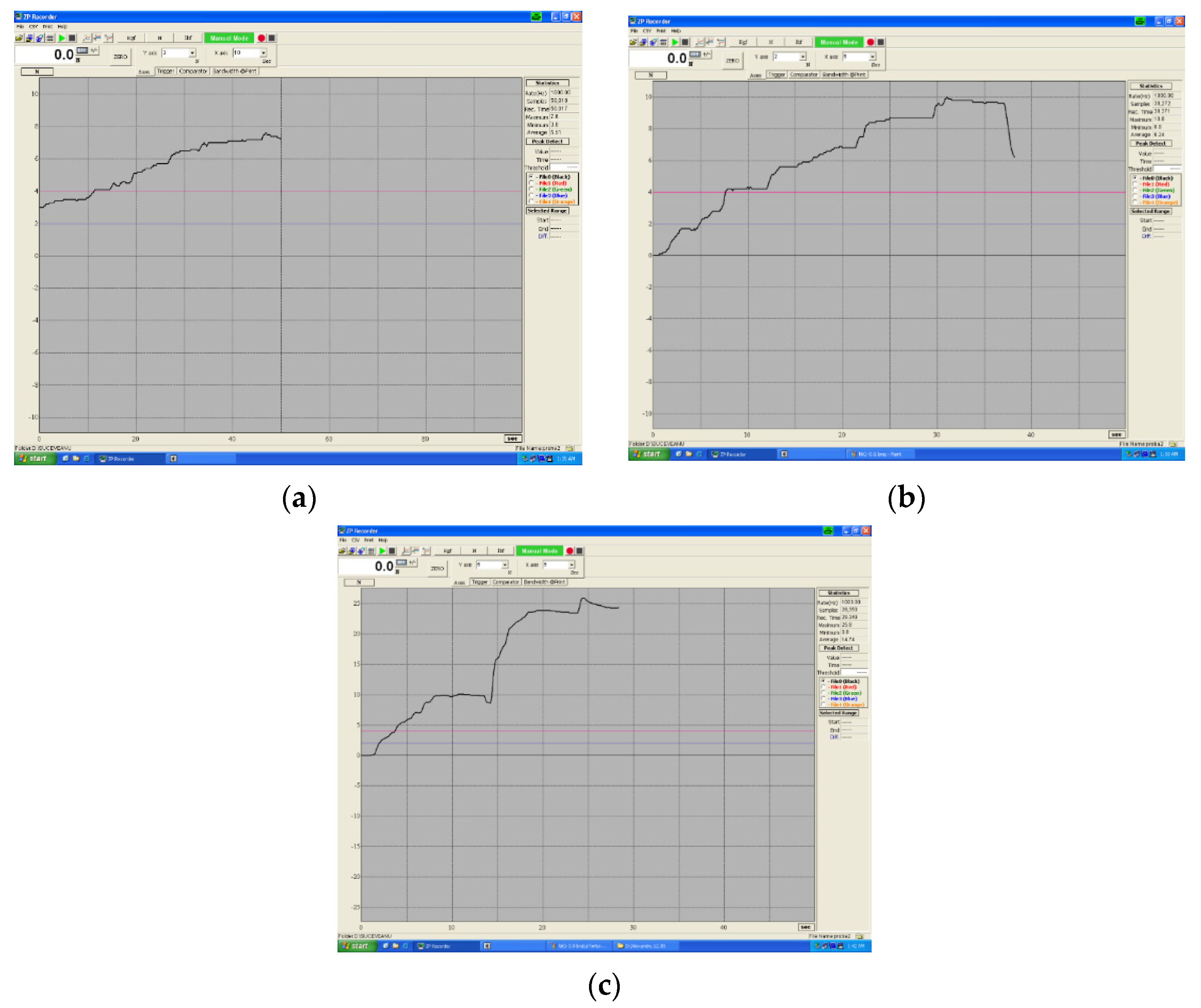

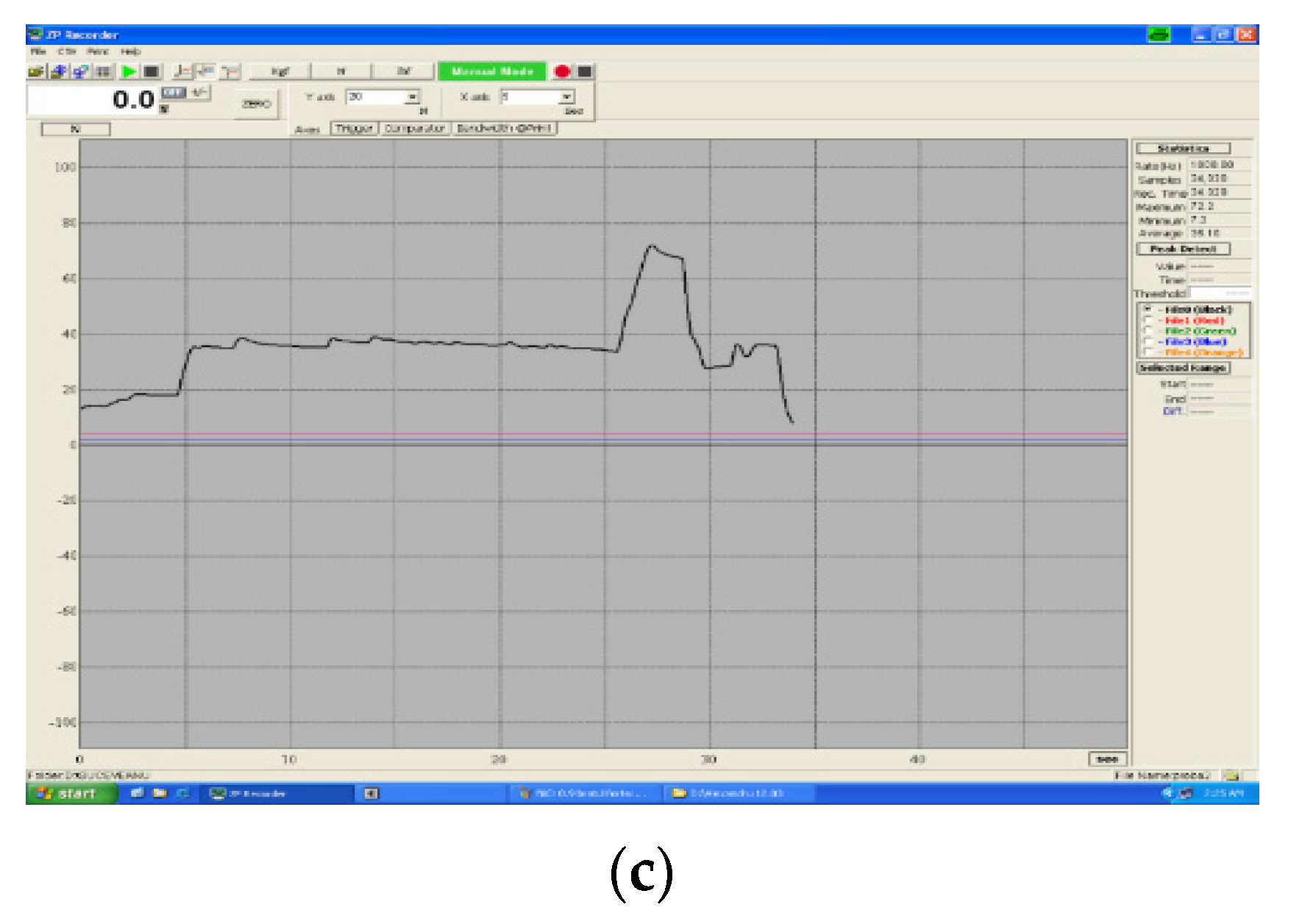
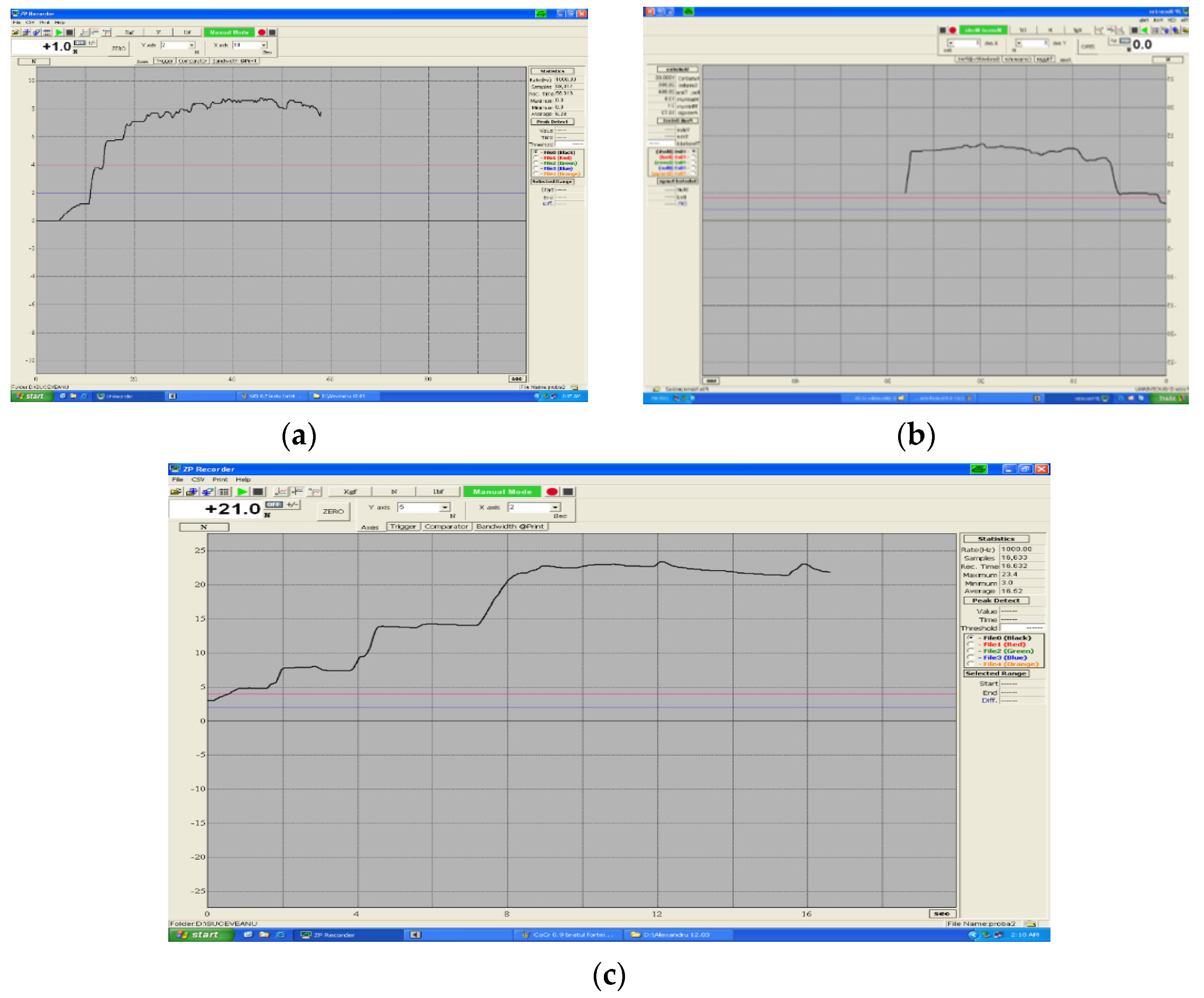
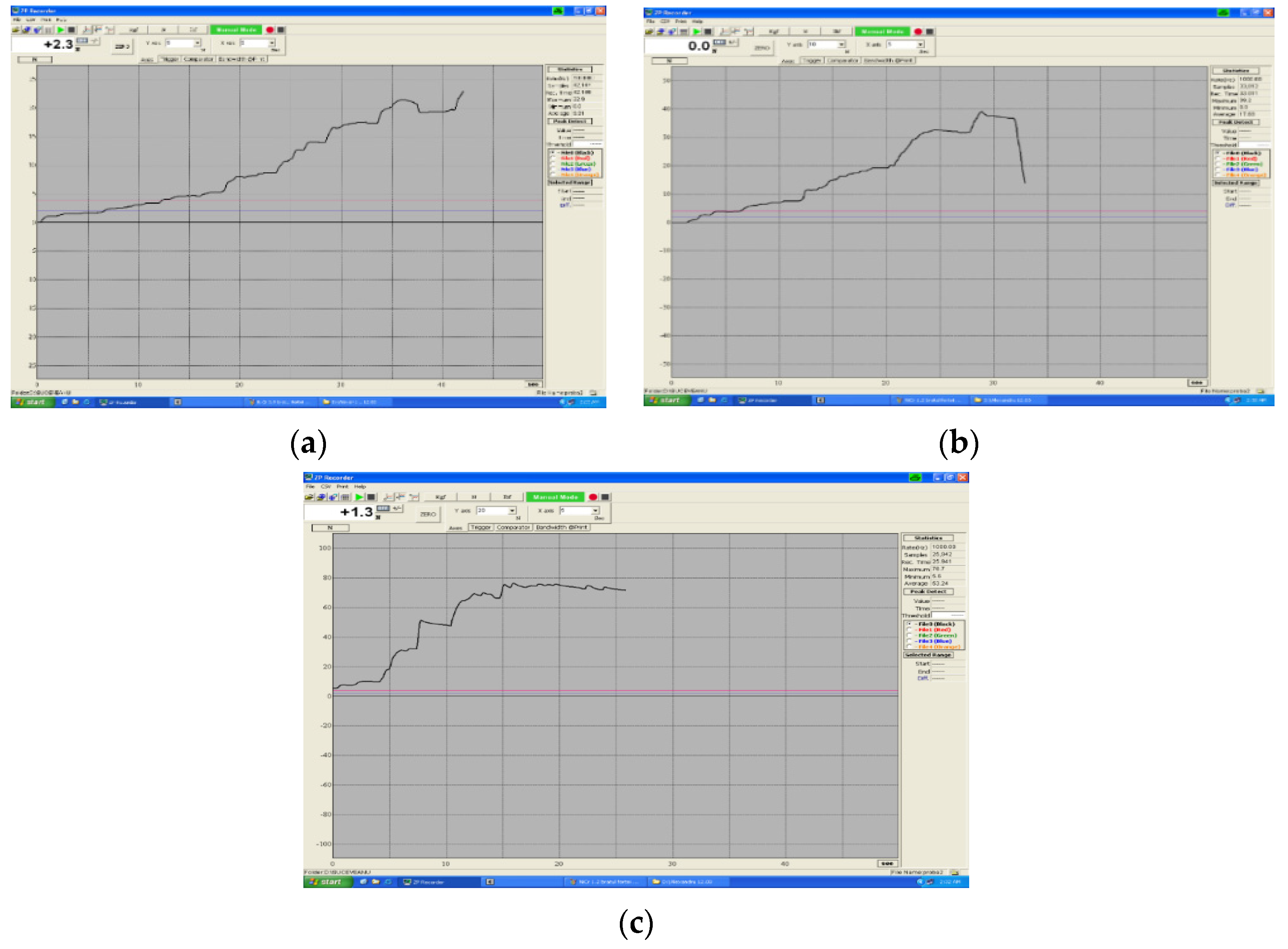

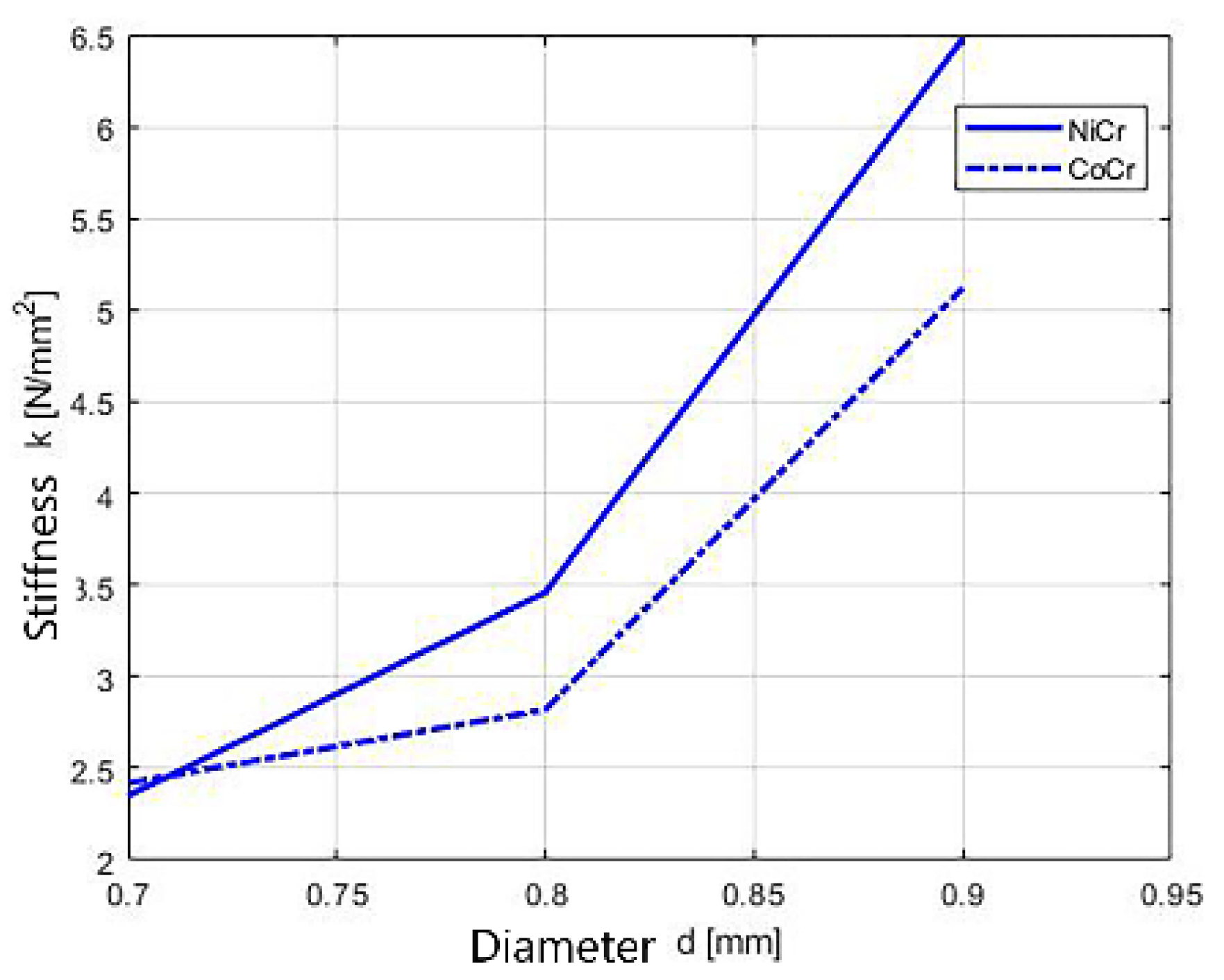


| Deflection mm | Ni Cr 0.7 mm | Ni Cr 0.7 mm | Ni Cr 0.7 mm | Ni Cr 0.7 mm | Ni Cr 0.7 mm | ||||||||||
|---|---|---|---|---|---|---|---|---|---|---|---|---|---|---|---|
| 1 Month in Artificial Saliva | 2 Months in Artificial Saliva | 1 Month in Artificial Saliva + Cola | 2 Months in Artificial Saliva + Cola | ||||||||||||
| l3 15 mm F(N) | l2 10 mm F(N) | l1 5 mm F(N) | l3 15 mm F(N) | l2 10 mm F(N) | l1 5 mm F(N) | l3 15 mm F(N) | l2 10 mm F(N) | l1 5 mm F(N) | l1 15 mm F(N) | l2 10 mm F(N) | l1 5 mm F(N) | l3 15 mm F(N) | l2 de 10 mm F(N) | l1 5 mm F(N) | |
| 1 | 0.7 | 2 | 7 | 0.5 | 0.4 | 4 | 0.4 | 0.6 | 6.3 | 0.4 | 0.7 | 1.2 | 0.4 | 1 | 4.2 |
| 2 | 1.4 | 4 | 16 | 1.6 | 2.9 | 30 | 1.4 | 2.8 | 20 | 0.8 | 2.2 | 6.2 | 1.3 | 3.7 | 12 |
| 3 | 2.3 | 6 | 22 | 3 | 5.8 | 2.7 | 4.7 | 1.8 | 5.1 | 10 | 2.4 | 6.6 | 21 | ||
| 4 | 3.1 | 7.5 | 4.2 | 14.6 | 4.7 | 3 | 7.2 | 16.8 | 3.1 | 8.5 | |||||
| 5 | 3.9 | 7.8 | 5 | 20 | 11 | 3.8 | 8.1 | 3.8 | 12 | ||||||
| 6 | 4.5 | 5.4 | 4.5 | 14 | 4.5 | ||||||||||
| 7 | 4.9 | 7.1 | 5 | 4.8 | |||||||||||
| 8 | 5.2 | 14.3 | 5.1 | 5 | |||||||||||
| 9 | 5.3 | 20 | 8 | 6.6 | |||||||||||
| 10 | 5.4 | ||||||||||||||
| residual deflection of spring mm | 3 | 1 | 1.05 | 3.5 | 1.28 | 0.31 | 1.05 | 0.65 | 0.66 | 1.11 | 1.06 | 0.6 | 2.3 | 1.03 | 0.59 |
| Deflection mm | Co-Cr 0.7 mm | Co-Cr 0.7 mm | Co-Cr 0.7 mm | Co-Cr 0.7 mm | Co-Cr 0.7 mm | ||||||||||
|---|---|---|---|---|---|---|---|---|---|---|---|---|---|---|---|
| 1 Month in Artificial Saliva | 2 Months in Artificial Saliva | 1 Month in Artificial Saliva + Cola | 2 Months in Artificial Saliva + Cola | ||||||||||||
| l3 15 mm F(N) | l2 10 mm F(N) | l1 5 mm F(N) | l3 15 mm F(N) | l2 10 mm F(N) | l1 5 mm F(N) | l3 15 mm F(N) | l2 10 mm F(N) | l1 5 mm F(N) | l1 15 mm F(N) | l2 10 mm F(N) | l1 5 mm F(N) | l3 15 mm F(N) | l2 de 10 mm F(N) | l1 5 mm F(N) | |
| 1 | 0.9 | 2.4 | 7 | 0.4 | 0.7 | 1.6 | 0.9 | 1.6 | 1.5 | 0.4 | 0.9 | 2 | 0.4 | 0.7 | 2.2 |
| 2 | 2 | 5 | 6 | 0.9 | 1.6 | 7.6 | 3 | 3.5 | 9.2 | 1.4 | 3.1 | 9 | 1.5 | 2.4 | 6.8 |
| 3 | 3 | 6.5 | 7 | 1.6 | 2.4 | 13 | 2.8 | 12 | 2.4 | 5 | 18 | 2.5 | 3.8 | 15.2 | |
| 4 | 3.8 | 9.6 | 2.6 | 2.1 | 24 | 3.2 | 16.4 | 3.2 | 9.7 | 3 | 4.9 | ||||
| 5 | 4.1 | 4.5 | 3.3 | 2.3 | 12 | 3.5 | 18.5 | 3.7 | 15.2 | 3.3 | 5.1 | ||||
| 6 | 4.2 | 4.3 | 3.6 | 4 | 9 | 3.7 | 3.9 | 3.6 | 14.5 | ||||||
| 7 | 4.4 | 4.2 | 3.7 | 2.4 | 8.9 | 13.5 | 4 | 3.7 | |||||||
| 8 | 4.4 | 4.1 | 4.1 | 3.4 | |||||||||||
| 9 | 4.4 | 4.3 | 4.3 | 1.4 | |||||||||||
| 10 | |||||||||||||||
| residual deflection of spring mm | 2.7 | 1.2 | 0.67 | 3.20 | 2.10 | 1.20 | 2.10 | 1.45 | 0.50 | 2.52 | 1.8 | 0.7 | 2.8 | 1.28 | 1.24 |
| Deflection mm | Ni Cr 0.9 mm | Ni Cr 0.9 mm | Ni Cr 0.9 mm | Ni Cr 0.9 mm | Ni Cr 0.9 mm | ||||||||||
|---|---|---|---|---|---|---|---|---|---|---|---|---|---|---|---|
| 1 Month in Artificial Saliva | 2 Months in Artificial Saliva | 1 Month in Artificial Saliva + Cola | 2 Months in Artificial Saliva + Cola | ||||||||||||
| l3 15 mm F(N) | l2 10 mm F(N) | l1 5 mm F(N) | l3 15 mm F(N) | l2 10 mm F(N) | l1 5 mm F(N) | l3 15 mm F(N) | l2 10 mm F(N) | l1 5 mm F(N) | l1 15 mm F(N) | l2 10 mm F(N) | l1 5 mm F(N) | l3 15 mm F(N) | l2 de 10 mm F(N) | l1 5 mm F(N) | |
| 1 | 2 | 4 | 18.2 | 1 | 1.5 | 2 | 1 | 1.5 | 1.8 | 0.9 | 2.1 | 4.5 | 1.1 | 1.2 | 1.7 |
| 2 | 4 | 9 | 37 | 1.9 | 3.7 | 19 | 1.9 | 3.3 | 6 | 1.6 | 4.4 | 20 | 2.2 | 2.4 | 5.6 |
| 3 | 5.6 | 12.8 | 35 | 2.9 | 9.4 | 2.7 | 5.4 | 11.5 | 2.5 | 12 | 31 | 3.4 | 4.2 | 19 | |
| 4 | 6 | 14.4 | 4.4 | 27 | 3.6 | 7.5 | 3.2 | 33 | 6 | 8.6 | 26 | ||||
| 5 | 8 | 14.2 | 6.5 | 4.7 | 20 | 4.4 | 8.4 | 12.6 | |||||||
| 6 | 8.3 | 10 | 5.7 | 9 | 10.3 | 15.2 | |||||||||
| 7 | 8.4 | 15.2 | 7.2 | 11.3 | 28 | ||||||||||
| 8 | 9.7 | 11.7 | |||||||||||||
| 9 | |||||||||||||||
| 10 | |||||||||||||||
| residual deflection of spring mm | 0.87 | 0.9 | 1.66 | 0.97 | 0.45 | 0.39 | 0.76 | 0.68 | 0.67 | 0.76 | 0.52 | 0.40 | 0.57 | 1.18 | 1.08 |
| Deflection mm | Co-Cr 0.9 mm | Co-Cr 0.9 mm | Co-Cr 0.9 mm | Co-Cr 0.9 mm | Co Cr 0.9 mm | ||||||||||
|---|---|---|---|---|---|---|---|---|---|---|---|---|---|---|---|
| 1 Month in Artificial Saliva | 2 Months in Artificial Saliva | 1 Month in Artificial Saliva + Cola | 2 Months in Artificial Saliva + Cola | ||||||||||||
| l3 15 mm F(N) | l2 10 mm F(N) | l1 5 mm F(N) | l3 15 mm F(N) | l2 10 mm F(N) | l1 5 mm F(N) | l3 15 mm F(N) | l2 10 mm F(N) | l1 5 mm F(N) | l1 15 mm F(N) | l2 10 mm F(N) | l1 5 mm F(N) | l3 15 mm F(N) | l2 de 10 mm F(N) | l1 5 mm F(N) | |
| 1 | 1.2 | 4.9 | 14 | 2.5 | 5.2 | 12 | 1 | 1.5 | 3.1 | 2 | 4.4 | 15 | 0.9 | 1.2 | 2 |
| 2 | 3.8 | 11 | 22 | 4.7 | 10 | 18 | 1.6 | 3.1 | 12.2 | 4.9 | 11.8 | 24 | 2.1 | 5 | 11 |
| 3 | 5.8 | 13 | 19 | 6.6 | 13 | 2.1 | 7.9 | 7.5 | 16 | 4.3 | 10 | 19 | |||
| 4 | 7.1 | 12.7 | 18 | 7.6 | 13.2 | 3.6 | 20 | 8.8 | 16.5 | 6 | 13.2 | ||||
| 5 | 7.9 | 11 | 17 | 8.2 | 13.2 | 5.5 | 9.6 | 7.1 | 13.5 | ||||||
| 6 | 8.4 | 11 | 20 | 8.9 | 13.2 | 6.5 | 10.2 | 7.9 | 16 | ||||||
| 7 | 8.6 | 11 | 21 | 9 | 13.2 | 8.1 | 10.4 | 8.5 | |||||||
| 8 | 8.1 | 11 | 20 | 9.3 | 13.2 | 31 | 10.3 | 8.7 | |||||||
| 9 | |||||||||||||||
| 10 | |||||||||||||||
| residual deflection of spring mm | 3.37 | 0.72 | 0.49 | 4.00 | 1.69 | 1.13 | 2.15 | 0.96 | 0.26 | 4.71 | 1.89 | 0.20 | 2.18 | 3.25 | 0.85 |
| Deflection mm | Ni Cr 1.2 mm | Ni Cr 1.2 mm | Ni Cr 1.2 mm | Ni Cr 1.2 mm | Ni Cr 1.2 mm | ||||||||||
|---|---|---|---|---|---|---|---|---|---|---|---|---|---|---|---|
| 1 Month in Artificial Saliva | 2 Months in Artificial Saliva | 1 Month in Artificial Saliva + Cola | 2 Month in Artificial Saliva + Cola | ||||||||||||
| l3 15 mm F(N) | l2 10 mm F(N) | l1 5 mm F(N) | l3 15 mm F(N) | l2 10 mm F(N) | l1 5 mm F(N) | l3 15 mm F(N) | l2 10 mm F(N) | l1 5 mm F(N) | l1 15 mm F(N) | l2 10 mm F(N) | l1 5 mm F(N) | l3 15 mm F(N) | l2 de 10 mm F(N) | l1 5 mm F(N) | |
| 1 | 1.7 | 3.8 | 10 | 2.3 | 2.5 | 12.2 | 2.2 | 6.4 | 13.6 | 2.7 | 2.8 | 9.2 | 1.5 | 3.8 | 6.3 |
| 2 | 3.4 | 7.5 | 49 | 4.2 | 7.3 | 26 | 5.1 | 12.5 | 29 | 6.8 | 8.3 | 20 | 3.6 | 7.6 | 14 |
| 3 | 5.3 | 19 | 75 | 6.4 | 12 | 42 | 8.1 | 18 | 61 | 10 | 15 | 31 | 6 | 11.3 | 22 |
| 4 | 8.7 | 32.5 | 8 | 24 | 38 | 11.1 | 23 | 51 | 13.2 | 19.4 | 41 | 8.1 | 15 | ||
| 5 | 14 | 37 | 9.7 | 39 | 14 | 36 | 16 | 23.5 | 10.3 | 34 | |||||
| 6 | 17.3 | 13.8 | 16.2 | 18 | 27 | 12.3 | |||||||||
| 7 | 20 | 21.6 | 19.6 | 19.4 | 16.5 | ||||||||||
| 8 | 23 | 21 | |||||||||||||
| 9 | |||||||||||||||
| 10 | |||||||||||||||
| residual deflection of spring mm | 0.46 | 0.32 | 0.08 | 0.48 | 0.37 | 0.30 | 0.59 | 0.14 | 0.30 | 0.21 | 0.40 | 0.30 | 0.82 | 0.23 | 0.25 |
| Deflection mm | Co Cr 1.2 mm | Co Cr 1.2 mm | Co Cr 1.2 mm | Co Cr 1.2 mm | Co Cr 1.2 mm | ||||||||||
|---|---|---|---|---|---|---|---|---|---|---|---|---|---|---|---|
| 1 Month in Artificial Saliva | 2 Months in Artificial Saliva | 1 Month in Artificial Saliva + Cola | 2 2 Months in Artificial Saliva + Cola | ||||||||||||
| l3 15 mm F(N) | l2 10 mm F(N) | l1 5 mm F(N) | l3 15 mm F(N) | l2 10 mm F(N) | l1 5 mm F(N) | l3 15 mm F(N) | l2 10 mm F(N) | l1 5 mm F(N) | l1 15 mm F(N) | l2 10 mm F(N) | l1 5 mm F(N) | l3 15 mm F(N) | l2 de 10 mm F(N) | l1 5 mm F(N) | |
| 1 | 4.6 | 6.9 | 31 | 3.3 | 7.8 | 17 | 5.2 | 6 | 9.8 | 4.6 | 5 | 12.2 | 3.6 | 2.3 | 6.9 |
| 2 | 12.4 | 20 | 61 | 7.9 | 16 | 36 | 9.7 | 10.5 | 22 | 8.8 | 12 | 37 | 6.1 | 6.3 | 23 |
| 3 | 19 | 29.8 | 85 | 11.9 | 23 | 16 | 17.5 | 43 | 17 | 24 | 48 | 12.4 | 13 | 38 | |
| 4 | 23 | 31 | 15 | 24 | 24 | 22 | 34 | 20.5 | 24 | ||||||
| 5 | 25 | 17 | 27 | 29 | 25 | 23.4 | 53 | ||||||||
| 6 | 25 | 25 | 27.5 | 26 | 24.5 | ||||||||||
| 7 | 24 | 26.2 | |||||||||||||
| 8 | 23 | 25.5 | |||||||||||||
| 9 | |||||||||||||||
| 10 | |||||||||||||||
| residual deflection of spring mm | 3.44 | 0.65 | 0.7 | 1.45 | 0.33 | 0.33 | 2.58 | 0.86 | 0.20 | 3.15 | 0.70 | 0.45 | 2.62 | 0.90 | 0.33 |
Publisher’s Note: MDPI stays neutral with regard to jurisdictional claims in published maps and institutional affiliations. |
© 2022 by the authors. Licensee MDPI, Basel, Switzerland. This article is an open access article distributed under the terms and conditions of the Creative Commons Attribution (CC BY) license (https://creativecommons.org/licenses/by/4.0/).
Share and Cite
Zalana, A.S.; Dămășaru, M.; Moraru, E.; Rizescu, C.I.; Neagoe, S.; Păcurar, M. Experimental Study on the Mechanical Behavior of Orthodontic Arches Exposed to the Environment in the Oral Cavity. Children 2022, 9, 107. https://doi.org/10.3390/children9010107
Zalana AS, Dămășaru M, Moraru E, Rizescu CI, Neagoe S, Păcurar M. Experimental Study on the Mechanical Behavior of Orthodontic Arches Exposed to the Environment in the Oral Cavity. Children. 2022; 9(1):107. https://doi.org/10.3390/children9010107
Chicago/Turabian StyleZalana, Alexandru Stefan, Maria Dămășaru, Edgar Moraru, Ciprian Ion Rizescu, Simina Neagoe (Chelărescu), and Mariana Păcurar. 2022. "Experimental Study on the Mechanical Behavior of Orthodontic Arches Exposed to the Environment in the Oral Cavity" Children 9, no. 1: 107. https://doi.org/10.3390/children9010107
APA StyleZalana, A. S., Dămășaru, M., Moraru, E., Rizescu, C. I., Neagoe, S., & Păcurar, M. (2022). Experimental Study on the Mechanical Behavior of Orthodontic Arches Exposed to the Environment in the Oral Cavity. Children, 9(1), 107. https://doi.org/10.3390/children9010107







